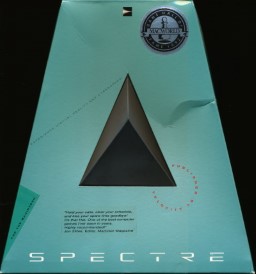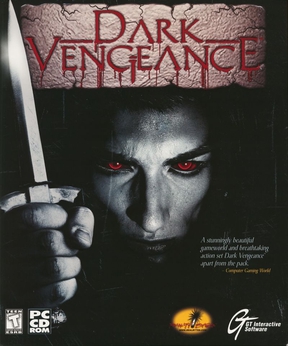
The Nintendo 64 (N64) is a home video game console developed and marketed by Nintendo. It was released in Japan on June 23, 1996, in North America on September 29, 1996, and in Europe and Australia on March 1, 1997. The successor to the Super Nintendo Entertainment System, it was the last major home console to use cartridges as its primary storage format until the Nintendo Switch in 2017. As a fifth-generation console, the Nintendo 64 primarily competed with Sony's PlayStation and the Sega Saturn.

Adobe PageMaker is a desktop publishing computer program introduced in 1985 by the Aldus Corporation on the Apple Macintosh. The combination of the Macintosh's graphical user interface, PageMaker publishing software, and the Apple LaserWriter laser printer marked the beginning of the desktop publishing revolution. Ported to PCs running Windows 1.0 in 1987, PageMaker helped to popularize both the Macintosh platform and the Windows environment.

Star Trek: The Next Generation – A Final Unity is an adventure game by Spectrum HoloByte, based on the Star Trek universe. It was released in 1995 for DOS and later ported to the Macintosh. It puts the player in control of Captain Picard and his crew of the Enterprise D and features traditional point-and-click adventure gameplay as well as free-form space exploration, diplomatic encounters and tactical ship-to-ship combat.

A/UX is a Unix-based operating system from Apple Computer for Macintosh computers, integrated with System 7's graphical interface and application compatibility. It is Apple's first official Unix-based operating system, launched in 1988 and discontinued in 1995 with version 3.1.1. A/UX requires select 68k-based Macintosh models with an FPU and a paged memory management unit (PMMU), including the Macintosh II, SE/30, Quadra, and Centris series.

Prisoner of Ice is an adventure game developed and released by Infogrames Multimedia for IBM PC compatibles and Macintosh in 1995 in America and Europe. It is based on H. P. Lovecraft's Cthulhu Mythos, particularly At the Mountains of Madness, and is a follow-up to Infogrames' earlier Shadow of the Comet. In 1997, the game was ported to the Sega Saturn and PlayStation exclusively in Japan.

Star Wars: Dark Forces is a first-person shooter video game developed and published by LucasArts. It was released in 1995 for MS-DOS and Macintosh, and in 1996 for the PlayStation. The story is set in the fictional Star Wars expanded universe and begins shortly before the original Star Wars film, before flashing forward to a year after the film's events. The game's protagonist and playable character is Kyle Katarn, a mercenary working on behalf of the Rebel Alliance who discovers the Galactic Empire's secret Dark Trooper Project, which involves the development of a series of powerful new battle droids and power-armored stormtroopers.

Syndicate is an isometric real-time tactical and strategic game from Bullfrog Productions created in 1993, and released for a variety of platforms beginning with the PC and Commodore Amiga. It is the first title in the Syndicate series. Set in a dystopian future in which corporations have replaced governments, Syndicate puts the player in control of a corporation vying for global dominance.

After Dark is a series of computer screensaver software introduced by Berkeley Systems in 1989 for the Apple Macintosh, and in 1991 for Microsoft Windows.

Microsoft Internet Explorer 2 (IE2) is the second, and by now discontinued, version of Internet Explorer (IE), a graphical web browser by Microsoft. It was unveiled in October 1995, and was released on November 27, 1995, for Microsoft Windows, and on April 23, 1996, for Apple Macintosh.

Terminal Velocity is a shooter video game originally developed by Terminal Reality and published by 3D Realms for DOS and Windows 95, and MacSoft for Mac OS. It is an arcade-style flight combat game, with simpler game controls and physics than flight simulators. It is known for its fast, high-energy action sequences, compared to flight simulators of the time.

Monster Truck Madness is a racing video game developed by Terminal Reality and published by Microsoft. It was released in North America on September 9, 1996. The game has twelve monster trucks and tasks the player with beating computer opponents. Checkpoints, multiple hidden shortcuts, and interactable objects commonly appear in the tracks. In the garage, the player modifies the truck to account for terrain surfaces. Online multiplayer is accessed with a modem, a local area network (LAN), or TCP/IP.
Think C, originally known as LightSpeed C, is an extension of the C programming language for the classic Mac OS developed by THINK Technologies, released first in mid-1986. THINK was founded by Andrew Singer, Frank Sinton and Mel Conway. LightSpeed C was widely lauded when it was released, as it used the Macintosh user interface throughout and was extremely fast. It quickly became the de facto C environment on the Mac, and the related Think Pascal quickly did the same for Object Pascal development.

MechWarrior 2: 31st Century Combat is a vehicle simulation game developed and published by Activision, released in 1995 as part of the MechWarrior series of video games in the BattleTech franchise. The game is set in 3057, and is played as a tactical simulation that incorporates aspects of real-time first-person combat and the physical simulation of the player's mech. It is a game recreation of the "Refusal War." The player can join one of the clans, Clan Jade Falcon or Clan Wolf while engaging in up to 32 missions.

The Settlers II, originally released as The Settlers II: Veni, Vidi, Vici, is a 1996 city-building game with real-time strategy elements for MS-DOS, Mac OS, and Nintendo DS. Developed and published by Blue Byte Software, the DOS version was released in Germany in April 1996, and in the United Kingdom and North America in August. In December, Blue Byte released an expansion, The Settlers II Mission CD, featuring new single-player campaign missions, new maps for both single-player and multiplayer modes, and a map editor. In October 1997, they released The Settlers II: Gold Edition, containing the original game, plus the Mission CD expansion, along with minor graphical enhancements and gameplay tweaks. The Gold Edition was also ported to Mac OS in September 1997. In 2006, an enhanced remake, The Settlers II , was released for Windows. In 2007, the Gold Edition was ported to the Nintendo DS, under the title The Settlers and released in Germany in July, and the United Kingdom and North America in August. Although adapted for the dual-screen display of the DS, and with controls specifically programmed for use with the DS stylus, the gameplay, game mechanics, graphics and storyline are unaltered. In 2009, the original Gold Edition was released on GOG.com, and in 2018, it was re-released for Windows as The Settlers II: Veni, Vidi, Vici - History Edition. It is the second game in The Settlers series, following The Settlers (1993).

Spectre is a video game for the Macintosh, developed in 1990 by Peninsula Gameworks and published in 1991 by Velocity Development. It is a 3D vector graphics tank battle reminiscent of the arcade game Battlezone. One sequel, Spectre VR, appeared on a number of lists of best video games.

Battle-Girl is a multidirectional shooter video game developed by Ultra/United Games and originally published in 1997 by Power Media for the Macintosh. In the game, players assume the role of the titular character taking control of her Soyuz 1183-A BattleCraft to save the Great Machine by eradicating malicious programmers released by Terminus, a weapon of Chaos. Its gameplay uses a two-joystick configuration reminiscent of Robotron: 2084.

Shockwave Assault is a science fiction combat flight simulation video game developed by Advanced Technology Group and published by Electronic Arts for various home video game consoles and PCs. The player takes control of a futuristic fighter plane to defeat extraterrestrial ships and tripods.

Sensory Overload is a first-person shooter video game developed and published by Reality Bytes for the Macintosh.

Paparazzi!: Tales of Tinseltown is a video game developed by American studio Museworthy and published by Activision for the Macintosh, Windows 3.x and Windows 95.

Dark Vengeance is an action video game developed by Reality Bytes and published by GT Interactive for Windows and Macintosh in 1998.



















